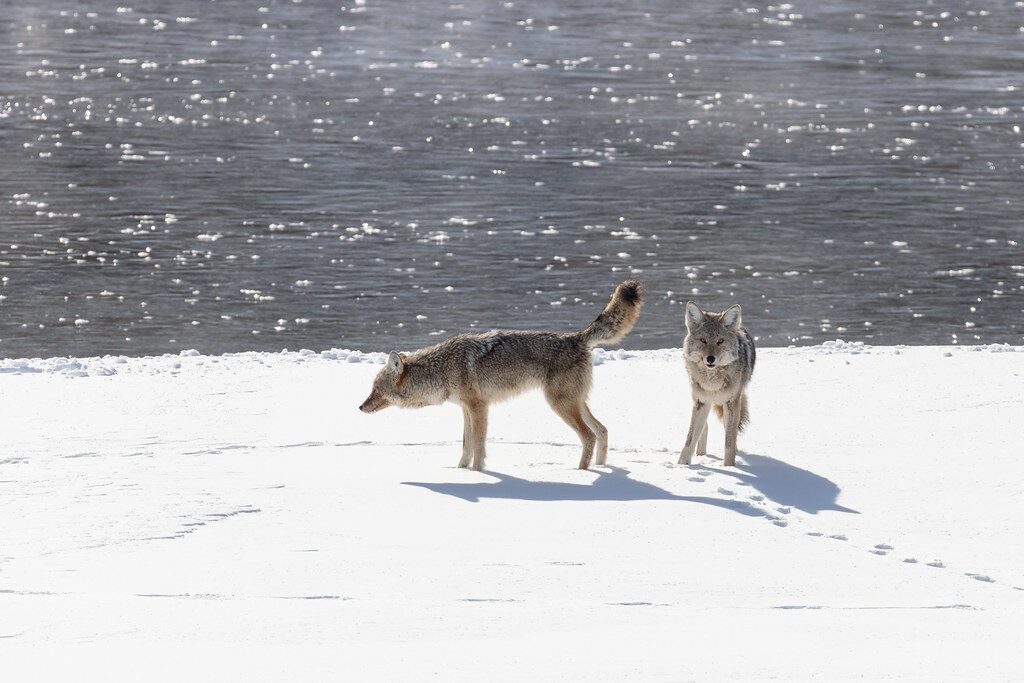As coyote lay there on the side of the mountain, lost in fantasies of returning to Coyote Woman’s village, he heard a noise off in the distance like the sound of many animals running. This stirred him from his quiet contemplation and he looked down into the valley to see a whole herd of animals from Coyote Woman’s tribe heading in his direction. She was leading them, stopping from time to time to sniff the ground in order to pick up Coyote’s scent. While they were still some distance away, they would be upon him before nightfall.
Still weary from his journey, Coyote arose and ran down the other side of the mountain to escape. Seeing a shallow creek before him, he jumped in and walked its length for a while to mask his scent from his pursuers.

The instant his paws touched the icy water he shivered and nearly leapt out again, but after a moment he gathered his will and his wits and forced himself to continue on, taking care not to let his flaming tail dip into the water.
As he
ran through the freezing water of the creek, his body gradually became
accustomed to the cold and after a time he found it invigorating, giving him
energy he didn’t knew he had. This newfound energy spurred him on.
13.0 Resurrection
“If the hero in his triumph wins the blessing of the goddess or the god and is then explicitly commissioned to return to the world with some elixir for the restoration of society, the final stage of his adventure is supported by all the powers of his supernatural patron. On the other hand, if the trophy has been attained against the opposition of its guardian, or if the hero’s wish to return to the world has been resented by the gods or demons, then the last stage of the mythological round becomes a lively, often comical, pursuit. This flight may be complicated by marvels of magical obstruction and evasion.”
–Joseph Campbell
This stage in the Hero’s journey is a counterpoint to the Call to Adventure. In that leg of the journey the hero had to cross the first threshold. In this part of the adventure the Magic Flight is undertaken in order to cross the return threshold. The Magic Flight consists of defeating the gatekeeper who guards the way home. The must return home with the Ultimate Boon but this time the anticipation of danger is replaced with visions of sanctuary, the warmth and love of home, and perhaps vindication from those who doubted the hero in the first place.
For the spiritual seeker who walks the Way of the Coyote, the Magic Flight may consist of letting go of forms of spirituality that are no longer meaningful. In ecospirituality, “spirit” simply means “that which inspires.” So a spiritual path in ecospirituality is one that inspires. Clinging to forms of spirituality that no longer provide a sense of wonder and awe about our places in the universe can be a type of Refusal of Return. If you find yourself stuck in a spiritual path that is no longer inspiring, you may be in need of the Magic Flight.
The Magic Flight leads to resurrection because it breathes new life into old, dead spiritual paths. It is a re-awakening, or a “revival,” if you prefer, that leads to renewed vigor and inspiration. How do we know if we are in need of a Magic Flight? Maybe this story will help to illustrate.
One warm spring day many decades ago I was at a lake with a woman I was dating at the time. We were having a picnic by the lake. She’d brought along her collection of talismans and other New Age paraphernalia and was busily trying to read portents in a deck of Tarot cards. Unfortunately, she had the habit of consulting the deck for every little aspect of her life to the point that it was almost an obsessive-compulsive disorder. It’s fine to see portents from time to time, but she couldn’t seem to see anything else.
As we sat there enjoying our lunch, she was dealing out her Tarot cards and obsessing over them to the exclusion of all else, missing the joy of the forest surrounding us. Suddenly a cardinal appeared on a tree branch just above our heads. Seeing an opportunity for yet another omen, she looked up at the bird and said, “Hi, do you have a message for me?”
The bird, in response, cocked her head sideways and dumped a prodigious load of excrement right onto her head.
I laughed, looked at her and said, “There’s your message.”
Spirituality
is only good when it isn’t taken too seriously. If you find yourself in a space
where the tools have become more important than the message, then you may benefit
from the Magic Flight.
In the Return Phase of our journey, the hero has gained wisdom about the nature of reality and consciousness, and is now faced with the challenge of returning to the world to teach those who are willing to listen. It is the process of coming home with the Holy Grail. It is the act of bringing the Ten Commandments down off the mountaintop. It is the act of helping others to achieve what the hero has achieved, while avoiding the temptation to turn them into carbon copies of himself. For a spiritual seeker, this means applying lessons learned in the spiritual realm to daily life. It means learning to see the bigger picture and to trust the vision. In ecospirituality, it is gaining the wisdom that we are not separate from nature, and that we are all one. It is the realization that in helping others I help myself.
In most hero stories the Magic Flight is the climax in which the hero (or heroine) must have the final and most dangerous encounter with death. It is Arthur confronting Mordred. It is Moses fighting for the Promised Land. It is Luke Skywalker confronting Darth Vader. The final battle also represents something far greater than the hero’s own existence. It is a world-changing event. Its outcome will have far-reaching consequences to the world he left behind and is now re-entering. Once the Magic Flight is undertaken, things can never go back to the way they were before. The hero has learned a new way of seeing and being in the world.
If she fails in her quest, it is not just she who will suffer. All of the members of her tribe who were left behind when she took up the journey will suffer too. But if she succeeds, the Magic Flight will lead her to victory and she will be reborn as the Master of Two Worlds.
13.1 Magic: Confidence in One’s True Nature
When I was a child, about seven years old, I dreamed of King Arthur and Merlin. In my childhood sense of awe and mystery, I wished to be a wizard studying under Merlin at Camelot. I remember one Thanksgiving when I was awarded the wishbone from the turkey. My sister and I made a wish, and I got the winning end.
What I wished for was a castle. After I made my wish I ran outside, expecting to find a castle in the back yard. In the childish wonderment of youth, I was actually disappointed when I didn’t find one.
We lived in the country back then, on a 400 acre farm owned by my grandfather. As I walked down the dirt road trying to hide my disappointment, I looked into the field next door to my family’s house. There was a grove of trees in the middle of the field. The grove had been covered over with kudzu. I’d seen that grove hundreds of times, but this time I saw it with new eyes. Something about the way the kudzu grew on the tallest trees looked like a castle turret. As I looked again, I began to see a fortress wall. The more I looked, the more my imagination transformed the kudzu into a castle. Right there before my eyes, my imagination had allowed my wish to come true!
To me, this is how all magic works. We don’t do magic to affect change in our external environment. We do magic to create change within ourselves. The rituals and tools of the shaman work to evoke change within us so that we may see things in a new way. The magic is always there, all around us. We simply have to change ourselves in order to be able to see it. If the way we’ve been seeing things is causing us to feel stress, or pain, or worry, then magic is the means by which we may heal ourselves so that we may begin to see the world in ways that do not hurt us.
What this ultimately means is that magic is confidence in self. As we become more accustomed to living according to our own true nature, we grow in the confidence that this is the correct way to live. It is a solution-focused approach that draws upon the power of intention.
We can talk about problems all day, but nothing gets solved until we start talking about solutions. To start talking about solutions, we may draw upon the power of intention by asking ourselves two questions:
1. What am I trying to accomplish with my life?
2. Is what I’m doing, thinking, feeling and believing helping me to accomplish this mission?
When we shift our thinking to a solution-focused approach, we create magic in the world for ourselves and for others. This magic, or sense of wonder, is what will allow us to successfully complete the Magic Flight.
13.2 Ancestral Magic
Our ancestors knew hundreds of medicinal uses of local plants and herbs. They knew the seasons, when to plant, when to harvest, how to forecast the weather by the behavior of plants and animals, and a host of other things based on their observations of nature. The lessons our ancestors learned haven’t gone away. They’re still there, waiting in the forest like an open book. All we have to do is to learn how to read it.
Before the advent of the written word, our ancestors had no books from which to learn; no sacred texts from which to grow their spirituality, and no written history of their peoples. Nature was their sacred text. They studied the forest in the way that we study books today.
Think about applying the power of intention to your studies of nature. Can you see the day-to-day changes in the trees as they grow through the seasons? What could you learn about the medicinal properties of the trees by paying closer attention to them? What can you learn about the qualities of each tree by studying it? Do different trees have different personalities? What can you learn about your own personality by studying the trees?
The more you increase your knowledge of nature by spending time in it and studying it, the more “magic” you gain. From this perspective, “magic” is simply the sense of awe and wonder we get from the beauty to be found in nature. This inspirational sense is the key to the Magic Flight that allows us to seek ecospirituality.

13.3 Animal as Teacher: My Own Animal Legend
If you look at the myths, legends and stories of indigenous peoples, you won’t have to look far to find that animals are used quite often as teaching tools. Remember Aesop’s Fables? Most of those parables involved animals. Likewise, many of our fairy tales, from Goldilocks and the Three Bears to the Three Little Pigs, involve animals.
You don’t have to be a shaman in order to use animals as teaching tools. You already have within you volumes of knowledge on animals and their characteristics. You can draw on these traits to create your own personal stories and legends, just as you draw on the archetypal energy of your own spirit animal.
The My Own Animal Legend exercise on the next pages is a method to use the knowledge within you as a way to teach others and yourself. The information and wisdom gained by completing this exercise will help you to gain the magic and the inspiration necessary to achieve your own Magic Flight.
To complete this exercise, first answer the questions provided, then go on to use that information to create your own Animal Legend. Don’t worry too much about being elaborate in your creativity. If the story comes from your own heart, it will be a good one.
It’s best to complete this exercise outdoors if possible. Use your own sacred space for this purpose, or if you are completing this workbook as part of an ecospirituality program, your instructor may have a place prepared for you. Call upon your own power animal when completing the questions. It may also help to have any personal talismans nearby so you may draw upon their energy when doing the exercise.
DON’T COMPLETE THE WORKSHEET BELOW UNTIL YOU HAVE COMPLETED THE PREVIOUS WORKSHEET!

